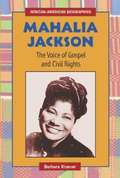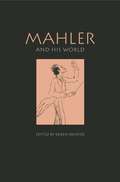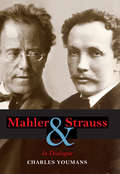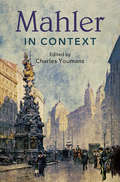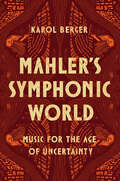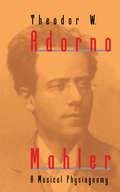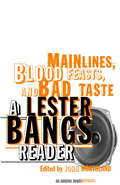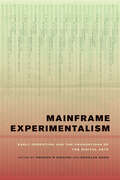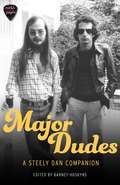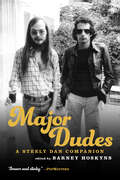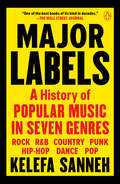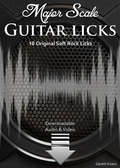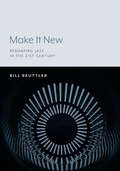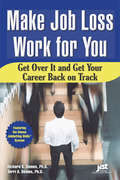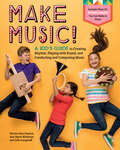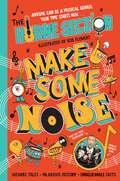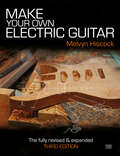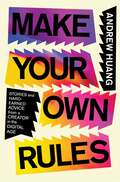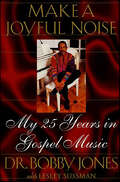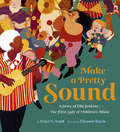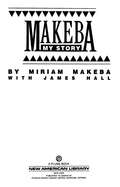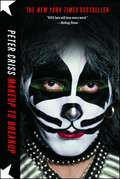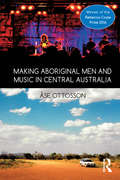- Table View
- List View
Mahalia Jackson: The Voice of Gospel and Civil Rights
by Barbara KramerBiography of African-American singer Mahalia Jackson.
Mahler and His World (The Bard Music Festival #49)
by Karen PainterFrom the composer's lifetime to the present day, Gustav Mahler's music has provoked extreme responses from the public and from experts. Poised between the Romantic tradition he radically renewed and the austere modernism whose exponents he inspired, Mahler was a consummate public persona and yet an impassioned artist who withdrew to his lakeside hut where he composed his vast symphonies and intimate song cycles. His advocates have produced countless studies of the composer's life and work. But they have focused on analysis internal to the compositions, along with their programmatic contexts. In this volume, musicologists and historians turn outward to examine the broader political, social, and literary changes reflected in Mahler's music. Peter Franklin takes up questions of gender, Talia Pecker Berio examines the composer's Jewish identity, and Thomas Peattie, Charles S. Maier, and Karen Painter consider, respectively, contemporary theories of memory, the theatricality of Mahler's art and fin-de-siècle politics, and the impinging confrontation with mass society. The private world of Gustav Mahler, in his songs and late works, is explored by leading Austrian musicologist Peter Revers and a German counterpart, Camilla Bork, and by the American Mahler expert Stephen Hefling. Mahler's symphonies challenged Europeans and Americans to experience music in new ways. Before his decision to move to the United States, the composer knew of the enthusiastic response from America's urban musical audiences. Mahler and His World reproduces reviews of these early performances for the first time, edited by Zoë Lang. The Mahler controversy that polarized Austrians and Germans also unfolds through a series of documents heretofore unavailable in English, edited by Painter and Bettina Varwig, and the terms of the debate are examined by Leon Botstein in the context of the late-twentieth-century Mahler revival.
Mahler and Strauss: In Dialogue
by Charles YoumansA rare case among history's great music contemporaries, Gustav Mahler (1860-1911) and Richard Strauss (1864-1949) enjoyed a close friendship until Mahler's death in 1911. Unlike similar musical pairs (Bach and Handel, Haydn and Mozart, Schoenberg and Stravinsky), these two composers may have disagreed on the matters of musical taste and social comportment, but deeply respected one another's artistic talents, freely exchanging advice from the earliest days of professional apprenticeship through the security and aggravations of artistic fame. Using a wealth of documentary material, this book reconstructs the 24-year relationship between Mahler and Strauss through collage--"a meaning that arises from fragments," to borrow Adorno's characterization of Mahler's Sixth Symphony. Fourteen different topics, all of central importance to the life and work of the two composers, provide distinct vantage points from which to view both the professional and personal relationships. Some address musical concerns: Wagnerism, program music, intertextuality, and the craft of conducting. Others treat the connection of music to related disciplines (philosophy, literature), or to matters relevant to artists in general (autobiography, irony). And the most intimate dimensions of life--childhood, marriage, personal character--are the most extensively and colorfully documented, offering an abundance of comparative material. This integrated look at Mahler and Strauss discloses provocative revelations about the two greatest western composers at the turn of the 20th century.
Mahler in Context (Composers in Context)
by Charles YoumansMahler in Context explores the institutions, artists, thinkers, cultural movements, socio-political conditions, and personal relationships that shaped Mahler's creative output. Focusing on the contexts surrounding the artist, the collection provides a sense of the complex crosscurrents against which Mahler was reacting as conductor, composer, and human being. Topics explored include his youth and training, performing career, creative activity, spiritual and philosophical influences, and his reception after his death. Together, this collection of specially commissioned essays offers a wide-ranging investigation of the ecology surrounding Mahler as a composer and a fuller appreciation of the topics that occupied his mind as he conceived his works. Readers will benefit from engagement with lesser known dimensions of Mahler's life. Through this broader contextual approach, this book will serve as a valuable and unique resource for students, scholars, and a general readership.
Mahler's Symphonic World: Music for the Age of Uncertainty
by Karol BergerA new analysis of Mahler’s symphonies, placing each within the context of his musical way of being in and experiencing the world. Between 1888 and 1909 Gustav Mahler completed nine symphonies and the orchestral song cycle Das Lied von der Erde; his tenth symphony was left incomplete at his death in 1911. Mahler’s Symphonic World provocatively suggests that over his lifetime, the composer pursued a single vision and a single, ideal symphony that strived to capture his personal outlook on human existence. Writing at the turn of the twentieth century, when all trust in firm philosophical and spiritual foundations had evaporated, Mahler’s music reflected a deep preoccupation with human suffering and transience and a search for sources of possible consolation. In Karol Berger’s reading, each of the symphonies follows a similar trajectory, with an opening quest leading to the final unveiling of a transcendent, consolatory vision. By juxtaposing single movements—the opening Allegros, the middle movements, the Finales—across different works, Berger traces recurring plotlines and imagery and discloses the works’ multiple interrelationships as well as their cohesiveness around a central idea. Ultimately, Mahler’s Symphonic World locates Mahler’s music within the matrix of intellectual currents that defined his epoch and offers a revelatory picture of his musical way of being in the world.
Mahler: A Musical Physiognomy
by Theodor W. AdornoTheodor W. Adorno goes beyond conventional thematic analysis to gain a more complete understanding of Mahler's music through his character, his social and philosophical background, and his moment in musical history. Adorno examines the composer's works as a continuous and unified development that began with his childhood response to the marches and folk tunes of his native Bohemia. Since its appearance in 1960 in German, Mahler has established itself as a classic of musical interpretation. Now available in English, the work is presented here in a translation that captures the stylistic brilliance of the original. Theodor W. Adorno (1903-69), one of the foremost members of the Frankfurt school of critical theory, studied with Alban Berg in Vienna during the late twenties, and was later the director of the Institute of Social Research at the University of Frankfurt from 1956 until his death. His works include Aesthectic Theory, Introduction to the Sociology of Music, The Jargon of Authenticity, Prism, and Philosophy of Modern Music.
Main Lines, Blood Feasts, and Bad Taste
by John Morthland Lester BangsBefore his untimely death in 1982, Lester Bangs was inarguably the most influential critic of rock and roll. Writing in hyper-intelligent Benzedrine prose that calls to mind Jack Kerouac and Hunter S. Thompson, he eschewed all conventional thinking as he discussed everything from Black Sabbath being the first truly Catholic band to Anne Murray's smoldering sexuality. In Mainlines, Blood Feasts, Bad Taste fellow rock critic John Morthland has compiled a companion volume to Psychotic Reactions and Carburetor Dung, the first, now classic collection of Bangs's work. Here are excerpts from an autobiographical piece Bangs wrote as a teenager, travel essays, and, of course, the music pieces, essays, and criticism covering everything from titans like Miles Davis, Lou Reed, and the Rolling Stones to esoteric musicians like Brian Eno and Captain Beefheart. Singularly entertaining, this book is an absolute must for anyone interested in the history of rock.From the Trade Paperback edition.
Main Lines, Blood Feasts, and Bad Taste: A Lester Bangs Reader
by John MorthlandBefore his untimely death in 1982, Lester Bangs was arguably the most influential critic of rock and roll. Writing in hyper-intelligent Benzedrine prose that calls to mind Jack Kerouac and Hunter S. Thompson, he eschewed all conventional thinking as he discussed everything from Black Sabbath being the first truly Catholic band to Anne Murray's smoldering sexuality. In Mainlines, Blood Feasts, Bad Taste fellow rock critic John Morthland has compiled a companion volume to Psychotic Reactions and Carburetor Dung, the first, now classic collection of Bangs's work. Here are excerpts from an autobiographical piece Bangs wrote as a teenager, travel essays, and, of course, the music pieces, essays, and criticism covering everything from titans like Miles Davis, Lou Reed, and the Rolling Stones to esoteric musicians like Brian Eno and Captain Beefheart. Singularly entertaining, this book is an absolute must for anyone interested in the history of rock.
Mainframe Experimentalism: Early Computing and the Foundations of the Digital Arts
by Douglas Kahn Hannah B. HigginsMainframe Experimentalism challenges the conventional wisdom that the digital arts arose out of Silicon Valley’s technological revolutions in the 1970s. In fact, in the 1960s, a diverse array of artists, musicians, poets, writers, and filmmakers around the world were engaging with mainframe and mini-computers to create innovative new artworks that contradict the stereotypes of "computer art." Juxtaposing the original works alongside scholarly contributions by well-established and emerging scholars from several disciplines, Mainframe Experimentalism demonstrates that the radical and experimental aesthetics and political and cultural engagements of early digital art stand as precursors for the mobility among technological platforms, artistic forms, and social sites that has become commonplace today.
Major Dudes: A Steely Dan Companion
by Barney Hoskyns'An indispensable compendium for Steely Dan fans' The WireAt its core a creative marriage between Donald Fagen and Walter Becker, Steely Dan are one of the defining and bestselling American rock acts of the last half-century, recording several of the cleverest and best-produced albums of the '70s - from the breathlessly catchy Can't Buy a Thrill to the sleekly sinister Gaucho.In the '90s they returned to remind us of how sorely we had missed their elegance and erudition, subsequently recording Two Against Nature and Everything Must Go during the following decade. They have sold close to forty-five million albums.'A lot of people think of them as the epitome of boring '70s stuff,' novelist William Gibson said in 1993, when Becker and Fagen toured for the first time in nineteen years. 'They don't realize this is probably the most subversive material pop has ever thrown up.'Now fully embraced by the 'Yacht Rock' generation - semi-ironic devotees of '70s Southern-California slickness - Steely Dan no longer polarize lo-fi punks and studio geeks in the way they used to. In 2001 they were inducted into the Rock and Roll Hall of Fame.Major Dudes collects some of the smartest and wittiest interviews Becker and Fagen have ever given, along with insightful reviews of - and commentary on - their extraordinary songs. Compiled by Rock's Backpages editor Barney Hoskyns, the book's contributors include Charles Shaar Murray, Robert Palmer, Ian MacDonald, Bud Scoppa, Penny Valentine, Fred Schruers, Sylvie Simmons and Michael Watts.
Major Dudes: A Steely Dan Companion
by Barney Hoskyns'An indispensable compendium for Steely Dan fans' The WireAt its core a creative marriage between Donald Fagen and Walter Becker, Steely Dan are one of the defining and bestselling American rock acts of the last half-century, recording several of the cleverest and best-produced albums of the '70s - from the breathlessly catchy Can't Buy a Thrill to the sleekly sinister Gaucho.In the '90s they returned to remind us of how sorely we had missed their elegance and erudition, subsequently recording Two Against Nature and Everything Must Go during the following decade. They have sold close to forty-five million albums.'A lot of people think of them as the epitome of boring '70s stuff,' novelist William Gibson said in 1993, when Becker and Fagen toured for the first time in nineteen years. 'They don't realize this is probably the most subversive material pop has ever thrown up.'Now fully embraced by the 'Yacht Rock' generation - semi-ironic devotees of '70s Southern-California slickness - Steely Dan no longer polarize lo-fi punks and studio geeks in the way they used to. In 2001 they were inducted into the Rock and Roll Hall of Fame.Major Dudes collects some of the smartest and wittiest interviews Becker and Fagen have ever given, along with insightful reviews of - and commentary on - their extraordinary songs. Compiled by Rock's Backpages editor Barney Hoskyns, the book's contributors include Charles Shaar Murray, Robert Palmer, Ian MacDonald, Bud Scoppa, Penny Valentine, Fred Schruers, Sylvie Simmons and Michael Watts.
Major Dudes: A Steely Dan Companion
by Barney HoskynsThe ultimate anthology of Steely Dan, one of the defining and bestselling rock acts of the last half-century At its core a creative marriage between Donald Fagen and Walter Becker, Steely Dan has sold over 45 million albums and recorded several of the cleverest and best-produced albums of the 1970s—from the breathlessly catchy Can’t Buy a Thrill to the sleekly sinister Gaucho—making them one of the most successful rock acts of the past fifty years. More than ten years after their break-up in 1981, they returned to remind fans of how sorely they had missed their elegance and erudition, subsequently recording Two Against Nature and Everything Must Go during the following decade, touring continuously, and being inducted into the Rock and Roll Hall of Fame in 2001. Major Dudes collects some of the smartest and wittiest interviews Becker and Fagen have ever given, along with insightful reviews of—and commentary on—their extraordinary songs. Compiled by leading music critic and writer Barney Hoskyns, Major Dudes features contributions from Chris Van Ness, Steven Rosen, and the late Robert Palmer, and pieces including rare interviews and reviews of Steely Dan’s early albums from Disc, Melody Maker, and Rolling Stone. With an afterword examining the musical legacy of and memorializing the late Walter Becker, who since his passing Rolling Stone has heralded as the “brilliant perfectionist behind one of rock’s most eccentric bands,” Major Dudes is the most comprehensive anthology of Steely Dan ever compiled and will be the centerpiece on every fan’s shelf.
Major Labels: A History of Popular Music in Seven Genres
by Kelefa SannehAn epic achievement and a huge delight, the entire history of popular music over the past fifty years refracted through the big genres that have defined and dominated it: rock, R&B, country, punk, hip-hop, dance music, and pop. <p><p> Kelefa Sanneh, one of the essential voices of our time on music and culture, has made a deep study of how popular music unites and divides us, charting the way genres become communities, shape-shifting across the years, giving us a way to track larger forces and controversies. In Major Labels, Sanneh distills a career’s worth of knowledge about music and musicians into a brilliant and omnivorous reckoning with popular music—as an art form (actually, a bunch of art forms), as a cultural and economic force, and as a tool that we use to build our identities. <p><p> As Sanneh unspools the stories of the genres that have defined popular music, the connections build, and big themes accrue momentum: the tension between mainstream and outsider, between authenticity and phoniness, between good and bad, right and wrong. Throughout, race is a powerful touchstone: just as there have always been Black audiences and white audiences, with more or less overlap depending on the moment, there has been Black music and white music, constantly mixing and separating. Sanneh debunks cherished myths, reappraises beloved heroes, and upends familiar ideas of musical greatness, arguing that sometimes, the best popular music isn’t transcendent. It expresses our grudges as well as our hopes, and it is motivated by greed as well as inspiration; music is a powerful tool for human connection, but also for human antagonism. <p><p> The book will intoxicate music nerds, even as it serves as a heady gateway drug for occasional listeners, or even non-listeners. The opposite of a modest proposal, Major Labels takes on the whole extraordinary range of popular music over the past half century, and it pays in full.
Major Scale Guitar Licks: 10 Original Soft Rock Licks with Audio & Video (Modal Guitar Licks #1)
by Gareth Evans10 original soft rock guitar licks from the major scale in tablature and notation for the progressing guitarist at intermediate level and above. >> 53 bars of music over 10 licks (average lick length 5.3 bars) >> Video at full speed & Audio at full & half speed (Downloadable) >> Backing tracks at full and slower practise speeds (Downloadable) >> Scale diagrams with theory and technique tips for each lick >> Guitar tablature has picking directions & fretting finger guide numbers Please Note: This eBook has written music and is not suitable for smaller screens.
Make It New: Reshaping Jazz in the 21st Century
by Bill BeuttlerAs jazz enters its second century it is reasserting itself as dynamic and relevant. Boston Globe jazz writer and Emerson College professor Bill Beuttler reveals new ways in which jazz is engaging with society through the vivid biographies and music of Jason Moran, Vijay Iyer, Rudresh Mahanthappa, The Bad Plus, Miguel Zenón, Anat Cohen, Robert Glasper, and Esperanza Spalding. These musicians are freely incorporating other genres of music into jazz—from classical (both western and Indian) to popular (hip-hop, R&B, rock, bluegrass, klezmer, Brazilian choro)—and other art forms as well (literature, film, photography, and other visual arts). This new generation of jazz is increasingly more international and is becoming more open to women as instrumentalists and bandleaders. Contemporary jazz is reasserting itself as a force for social change, prompted by developments such as the Black Lives Matter, #MeToo movements, and the election of Donald Trump.
Make Job Loss Work for You
by Terri Deems Richard DeemsReaders learn to tackle their emotional reactions to job loss--including shock, anger, denial, self-doubt, and depression--and come to an acceptance that enables them to move forward with their careers. Then, using the proven Deems JobGetting Skills System, readers can pinpoint their ideal career direction and make all the right moves toward landing a new job, including resume and cover letter tips, search strategy, offer negotiation, and success in the new position.
Make Music!: A Kid's Guide to Creating Rhythm, Playing with Sound, and Conducting and Composing Music (Music Makes A Difference Ser.)
by John Langstaff Ann Sayre Wiseman Norma Jean HaynesMusic is for everyone — no prior experience required! Make Music! invites kids and families to celebrate the joy of sound with a variety of inventive activities, including playing dandelion trumpets, conducting percussion conversations, and composing their own pieces. Musician and educator Norma Jean Haynes brings the pioneering work of Ann Sayre Wiseman and John Langstaff to a new generation of kids aged 5 and up, focusing on the playfulness, spontaneity, and creativity of music. Kids explore rhythm with clapping, body drumming, and intonations. They learn to create found sound with kitchen pots and pans, the Sunday paper, or even the Velcro on their sneakers. And step-by-step instructions show how to make 35 different instruments, from chimes and bucket drums to a comb kazoo and a milk carton guitar. This publication conforms to the EPUB Accessibility specification at WCAG 2.0 Level AA.
Make Some Noise: The mind-blowing guide to all things music by the world’s funniest band
by The Horne Section*The funniest band in the world, The Horne Section (fronted by Taskmaster's Alex Horne), tell you everything you need to know to be a music genius - with bizarre tales, absurd history and unbelievable facts.*'An explosion of silliness . . the whole family will get something from it' Guardian on The Horne Section TV showWith FUNNY tales, ABSURD history and UNBELIEVABLE facts, this mind-blowing guide to music can help anyone become a sound-making sensation.In this book, you'll find answers to those all-important questions, such as:- Why is cabbage the key to musical genius?- Which is the fartiest of all the instruments?- Which song has the FUNNIEST lyrics of all time?Band leader Alex Horne has also added some special tasks throughout the book, so readers will be making their own music in no time at all - without even leaving the house!
Make Your Own Electric Guitar
by David LacasaThe first choice of aspiring guitar makers for more than 30 years For some, it is not enough to buy a guitar—the challenge of designing and hand-making a unique, customized instrument is the dream. Since 1986, these people have turned to one book: Make Your Own Electric Guitar. Written in a clear, relaxed style, it covers every facet of guitar design and construction, as well as electronic theory and practice, and full woodworking and wiring techniques—all supported with plenty of photos and diagrams. Now in a revised and expanded third edition, Make Your Own Electric Guitar will enable any musician or enthusiast with basic woodworking skills to create a uniquely valuable instrument.
Make Your Own Rules: Stories and Hard-Earned Advice from a Creator in the Digital Age
by Andrew HuangYouTube sensation Andrew Huang offers practical tips and hard-won advice for creatives seeking financial stability while staying authentic.How does a musician with acute hearing loss, a refusal to perform live, and no industry connections carve a path to millions of followers and lucrative royalty checks? In Make Your Own Rules, Andrew Huang shares stories from his two decades as a music industry misfit and offers advice on both the artistic and business sides of working as a creator in our digital era. Beginning with auctioning his songwriting skills on eBay as a teenager, Andrew continuously found new ways to thrive in a music career over the last twenty-plus years. His storied career and hard-won wisdom can help aspiring digital creatives find success as well. Organized by sections on building your creative foundations, growing an audience in the digital age, making money, and staying true to yourself, Make Your Own Rules pairs personal anecdotes with concrete advice applicable to any freelance digital creator. You&’ll learn how Andrew became an early adopter of sharing music online—for free!—and how he leveraged social media to grow an organic following and amass millions of song streams and video views. Additional chapters provide insight into his designing an online course and music production tools that have been used by tens of thousands of people, and how he created revenue streams for himself that didn&’t exist previously. With open-minded perseverance, Andrew made up his own rules for life. His unlikely journey will inspire creators to find opportunity, financial stability, and fun in their pursuits.
Make a Joyful Noise: My 25 Years in Gospel Music
by Bobby Jones Lesley SussmanDr. Bobby Jones, a leading figure in the gospel music industry, offers a revealing look at his career and friendships with other celebrities.Jones is the host and executive producer of the world's number one gospel television program with a viewership exceeding five million. He shares with readers his own personal journey from an impoverished childhood where his love of education and Christian music played a major role in his becoming a prominent award-winning leader in the gospel music world. Jones counts many of gospel's most beloved celebrities as his friends, including Aretha Franklin, Shirley Caesar, Kirk Franklin, the Winans, and Barbara Mandrell. His book provides intimate and inspirational details of these friendships.
Make a Pretty Sound: A Story of Ella Jenkins—The First Lady of Children's Music
by Traci N. ToddOnce upon a time, children's music was just Mother Goose, nursery songs, and lullabies. And then came Ella Jenkins.Ella Jenkins is an American folk singer and living legend dubbed "The First Lady of Children’s Music." For nearly 70 years, she has been writing and performing music that has entertained and engaged generations of young listeners. In Make a Pretty Sound, Ella’s life and legacy are captured in vibrant sights, sounds, and stories that leap right off the page. Born in St. Louis, Missouri, and raised in Chicago, Ella grew up loving music of all kinds—the call-and-response of Cab Calloway, the exciting rhythms of Moroccan and Indian records spun in a local record shop, the bluesy notes her uncle teased from his harmonica. She listened to music from around the world, and no matter what language it was in, she could feel what it meant—the bridge in understanding and feeling that music offers from one heart to another. When she began working with children, she knew just what to do. She knew music would offer children a kinetic learning experience that engaged them physically, verbally, and empathetically, creating community out of song. Soon, she was recording her own albums and became an international star. In these beautifully illustrated pages, Ella’s journey—from the gritty streets of Chicago to the classrooms where she found her calling to an opportunity to raise her voice for freedom alongside Martin Luther King, Jr., to the spotlight of the world’s stage—is rhythmically, joyfully, brilliantly illuminated. For readers familiar with Ella Jenkins or new to her work, this nonfiction picture book offers a treasury of inspiration that touches on American history, civil rights, cultural awareness, and the incredible power of music.A LIVING LEGEND: Drawing on personal interviews the author conducted with Ella and her manager, this is Ella’s story told in her own words. For all who have felt the impact of her work in children's programming, in classrooms, and in their homes, this is a wonderful opportunity to explore the legacy of an artist who offers children the gift of music and the gift of knowing that another human heart reaches out to theirs. LYRICAL TEXT AND ART: Rhythmic text and colorful illustrations celebrate the musicality of Ella's life and convey the singular joy that is found in the sharing of music! BEAUTIFUL GIFT BOOK: With extraordinary writing and beautiful art, this book makes a perfect present for any young reader who loves music, biographies, or both.Perfect for: Fans of Ella Jenkins Parents, teachers, and caregivers of children who love music Teachers and librarians looking for a great picture book biography Anyone interested in multicultural music for kids Readers who enjoy the Little People, BIG DREAMS and Who Is/Who Was biography series Gift givers looking for a children’s music book for birthday, holiday, or any celebratory occasion
Makeba: My Story
by James A. HallThe renowned South African singer and political activist recounts her life--a life that encompasses the splendor of international acclaim, bitter personal tragedy, and political intrigue and violence
Makeup to Breakup: My Life In and Out of Kiss
by Peter CrissLEGENDARY founding KISS drummer Peter “Catman” Criss has lived an incredible life in music, from the streets of Brooklyn to the social clubs of New York City to the ultimate heights of rock ’n’ roll success and excess. KISS formed in 1973 and broke new ground with their elaborate makeup, live theatrics, and powerful sound. The band emerged as one of the most iconic hard rock acts in music history. Peter Criss, the Catman, was the heartbeat of the group. From an elevated perch on his pyrotechnic drum riser, he had a unique vantage point on the greatest rock show of all time, with the KISS Army looking back at him night after night. Peter Criscuola had come a long way from the homemade drum set he pounded on nonstop as a kid growing up in Brooklyn in the fifties. He endured lean years, street violence, and the rollercoaster music scene of the sixties, but he always knew he’d make it. Makeup to Breakup is Peter Criss’s eye-opening journey from the pledge to his ma that he’d one day play Madison Square Garden to doing just that. He conquered the rock world—composing and singing his band’s all-time biggest hit, “Beth” (1976)—but he also faced the perils of stardom and his own mortality, including drug abuse, treatment in 1982, near-suicides, two broken marriages, and a hard-won battle with breast cancer. Criss opens up with a level of honesty and emotion previously unseen in any musician’s memoir. Makeup to Breakup is the definitive and heartfelt account of one of rock’s most iconic figures, and the importance of faith and family. Rock ’n’ roll has been chronicled many times, but never quite like this.
Making Aboriginal Men and Music in Central Australia (Criminal Practice Ser.)
by Ase OttossonThis detailed ethnographic study explores the intercultural crafting of contemporary forms of Aboriginal manhood in the world of country, rock and reggae music making in Central Australia. Focusing on four different musical contexts – an Aboriginal recording studio, remote Aboriginal settlements, small non-indigenous towns, and tours beyond the musicians’ homeland – the author challenges existing scholarly, political and popular understandings of Australian Aboriginal music, men, and related indigenous matters in terms of radical social, cultural and racial difference. Based on extensive anthropological field research among Aboriginal rock, country and reggae musicians in small towns and remote desert settlements in Central Australia, the book investigates how Aboriginal musicians experience and articulate various aspects of their male and indigenous sense of selves as they make music and engage with indigenous and non-indigenous people, practices, places, and sets of values.Making Aboriginal Men and Music is a highly original, intimate study which advances our understanding of contemporary indigenous and male identity formation within Aboriginal Australian society. Providing new analytical insights for scholars and students in fields such as social and cultural anthropology, cultural studies, popular music, and gender studies, this engaging text makes a significant contribution to the study of indigenous identity formation in remote Australia and beyond.
